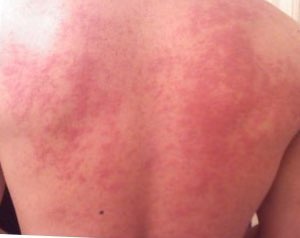Related Research Articles

Methylisothiazolinone, MIT, or MI, is the organic compound with the formula S(CH)2C(O)NCH3. It is a white solid. Isothiazolinones, a class of heterocycles, are used as biocides in numerous personal care products and other industrial applications. MIT and related compounds have attracted much attention for their allergenic properties, e.g. contact dermatitis.
A radioallergosorbent test (RAST) is a blood test using radioimmunoassay test to detect specific IgE antibodies in order to determine the substances a subject is allergic to. This is different from a skin allergy test, which determines allergy by the reaction of a person's skin to different substances.

p-Phenylenediamine (PPD) is an organic compound with the formula C6H4(NH2)2. This derivative of aniline is a white solid, but samples can darken due to air oxidation. It is mainly used as a component of engineering polymers and composites like kevlar. It is also an ingredient in hair dyes and is occasionally used as a substitute for henna.
Haptens are small molecules that elicit an immune response only when attached to a large carrier such as a protein; the carrier may be one that also does not elicit an immune response by itself. The mechanisms of absence of immune response may vary and involve complex immunological interactions, but can include absent or insufficient co-stimulatory signals from antigen-presenting cells.

A food allergy is an abnormal immune response to food. The symptoms of the allergic reaction may range from mild to severe. They may include itchiness, swelling of the tongue, vomiting, diarrhea, hives, trouble breathing, or low blood pressure. This typically occurs within minutes to several hours of exposure. When the symptoms are severe, it is known as anaphylaxis. A food intolerance and food poisoning are separate conditions, not due to an immune response.

Contact dermatitis is a type of acute or chronic inflammation of the skin caused by exposure to chemical or physical agents. Symptoms of contact dermatitis can include itchy or dry skin, a red rash, bumps, blisters, or swelling. These rashes are not contagious or life-threatening, but can be very uncomfortable.

A patch test is a diagnostic method used to determine which specific substances cause allergic inflammation of a patient's skin.

Soy allergy is a type of food allergy. It is a hypersensitivity to ingesting compounds in soy, causing an overreaction of the immune system, typically with physical symptoms, such as gastrointestinal discomfort, respiratory distress, or a skin reaction. Soy is among the eight most common foods inducing allergic reactions in children and adults. It has a prevalence of about 0.3% in the general population.

Allergic contact dermatitis (ACD) is a form of contact dermatitis that is the manifestation of an allergic response caused by contact with a substance; the other type being irritant contact dermatitis (ICD).

Isothiazolinone (sometimes isothiazolone) is an organic compound with the formula (CH)2SN(H)CO. A white solid, it is structurally related to isothiazole. Isothiazolone itself is of limited interest, but several of its derivatives are widely used preservatives and antimicrobials.
Perfume intolerance or perfume allergy is a condition wherein people exhibit sensitivity or allergic reactions to ingredients in some perfumes and some other fragrances. It is a form of multiple chemical sensitivity, a more general phenomenon for this diagnosis.

Iodopropynyl Butyl Carbamate (IPBC) is a water-soluble preservative used globally in the paints & coatings, wood preservatives, personal care, and cosmetics industries. IPBC is a member of the carbamate family of biocides. IPBC was invented in the 1970s and has a long history of effective use as an antifungal technology.
The Guinea pig maximisation test (GPMT) is an in vivo test to screen for substances that cause human skin sensitisation. It was first proposed by B. Magnusson and Albert Kligman in 1969 and described in their 1970 book Allergic Contact Dermatitis in the Guinea Pig.
The Buehler test is an in vivo test to screen for substances that cause human skin sensitisation. It was first proposed by Edwin Vernon Buehler in 1965 and further explained in 1980.
The murine local lymph node assay (LLNA) is an in vivo test for skin sensitisation.

Tetramethyl acetyloctahydronaphthalenes is a synthetic ketone fragrance also known as OTNE and by other commercial trade names such as: Iso E Super, Iso Gamma Super, Anthamber, Amber Fleur, Boisvelone, Iso Ambois, Amberlan, Iso Velvetone, Orbitone, Amberonne. It is a synthetic woody odorant and is used as a fragrance ingredient in perfumes, laundry products and cosmetics.

Nickel allergy is any of several allergic conditions provoked by exposure to the chemical element nickel. Nickel allergy often takes the form of nickel allergic contact dermatitis (Ni-ACD), a form of allergic contact dermatitis (ACD). Ni-ACD typically causes a rash that is red and itchy and that may be bumpy or scaly. The main treatment for it is avoiding contact with nickel-releasing metals, such as inexpensive jewelry. Another form of nickel allergy is a systemic form: systemic nickel allergy syndrome (SNAS) can mimic some of the symptoms of irritable bowel syndrome (IBS) and also has a dermatologic component.
The mouse ear swelling test is a toxicological test that aims to mimic human skin reactions to chemicals. It avoids post-mortem examination of tested animals.

Metal allergies inflame the skin after it has been in contact with metal. They are a form of allergic contact dermatitis. They are becoming more common, as of 2021, except in areas with regulatory countermeasures.
CP-GEP is a non-invasive prediction model for cutaneous melanoma patients that combines clinicopathologic (CP) variables with gene expression profiling (GEP). CP-GEP is able to identify cutaneous melanoma patients at low-risk for nodal metastasis who may forgo the sentinel lymph node biopsy (SLNB) procedure. The CP-GEP model was developed by the Mayo Clinic and SkylineDx BV, and it has been clinically validated in multiple studies.
References
- ↑ The Identification of Contact Allergens by Human Assay III. The Maximization Test: A Procedure for Screening and Rating Contact Sensitizers http://www.nature.com/jid/journal/v47/n5/abs/jid1966160a.html
- ↑ Kligman, A. M.; Epstein, W. (1975). "Updating the maximization test for identifying contact allergens". Contact Dermatitis. 1 (4): 231–239. doi:10.1111/j.1600-0536.1975.tb05389.x. PMID 1235254. S2CID 35702783.
- ↑ Kligman, A. M. (1966). "The identification of contact allergens by human assay. III. The maximization test: a procedure for screening and rating contact sensitizers". J. Invest. Dermatol. 47 (5): 393–409. doi: 10.1038/jid.1966.160 . PMID 5924294.
- ↑ http://garfield.library.upenn.edu/classics1985/A1985AUG6800001.pdf [ bare URL PDF ]
- ↑ "Opinion concerning the predictive testing of potentially cutaneous sensiting cosmetic ingredients or mixtures of ingredients adopted by the SCCNFP during the 11th plenary session of 17 February 2000 | Scientific Committees".
- ↑ DA Basketter, EW Scholes, I Kimber (1994). The performance of the local lymph node assay with chemicals identified as contact allergens in the human maximization test. Food and Chemical Toxicology, 1994 - Elsevier
- ↑ Zaghi, D; Maibach, HI (2009). "The local lymph node assay compared with the human maximization test as an indicator of allergic potency in humans using patch test clinic populations". Cutan Ocul Toxicol. 28 (2): 61–4. doi:10.1080/15569520902793627. PMID 19514928. S2CID 35683477.